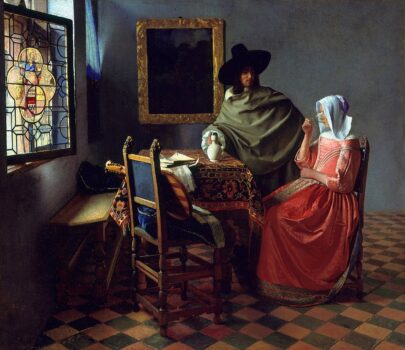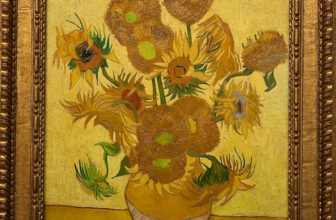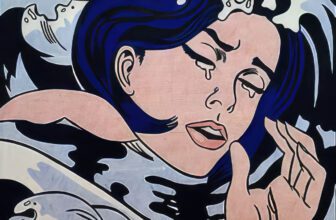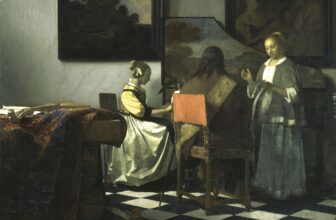What is The Meaning of The Wine Glass Painting
In a well known gallery of the Gemäldegalerie in Berlin, a modestly sized yet striking painting catches the eye of attentive visitors. At first glance, The Wine Glass by Johannes Vermeer appears to be a charming 17th-century domestic scene , a man and a woman in a sunlit room, a wine glass between them, and an atmosphere of courteous exchange. But like many of Vermeer’s works, this painting holds within it a web of subtle meanings, psychological tension, and visual mastery that rewards deep observation.
To fully appreciate The Wine Glass, one must step into Vermeer’s world: a time of cultural transformation in the Dutch Golden Age, where art was not just a reflection of daily life but a mirror of deeper moral, social, and intellectual concerns.
What Is The Wine Glass by Johannes Vermeer?
Painted around 1658–1660, The Wine Glass (also known as The Girl with the Wine Glass) is an oil painting on canvas measuring approximately 66.3 x 76.5 cm. It is widely considered one of Vermeer’s earlier mature works, marking a transitional moment in his artistic development , where his increasing mastery of light, perspective, and atmosphere becomes unmistakably his own.
In the scene, a young woman sits beside a table, elegantly dressed in a glowing red bodice and golden skirt. She is in the act of finishing a glass of wine, and her eyes are barely visible as her face is partly hidden by the glass she holds to her lips. A man, clad in a dark cloak and feathered hat, leans toward her with an ambiguous expression. He has either just poured the wine or is about to refill the glass. Behind them, a leaded glass window admits soft daylight, illuminating a shimmering tiled floor, richly textured carpet, and fine tableware. Above the couple hangs a framed painting of a classical figure holding a musical instrument.
On the surface, this is a familiar domestic moment , one of courtship, possibly seduction , yet Vermeer invites us to read much deeper.
The Artistic Context: What Type of Art Is The Wine Glass?
The Wine Glass belongs to the genre of Dutch genre painting, a category of art that flourished in the 17th century and portrayed scenes of everyday life. Yet Vermeer’s interpretation of this genre is anything but typical. Unlike his contemporaries such as Pieter de Hooch or Jan Steen , who often portrayed boisterous taverns, explicit moral lessons, or cluttered domestic spaces , Vermeer developed a refined, quiet, almost contemplative approach to genre scenes.
His works reflect a calculated balance of realism and idealization, of narrative and stillness. Though seemingly simple, The Wine Glass is layered with symbolism, coded social norms, and visual harmony. The quietude and subtle psychology of the scene push the painting into a realm beyond straightforward depiction , it becomes intimate theater, moral tableau, and technical marvel.
How and Who Painted The Wine Glass?
Johannes Vermeer, born in Delft in 1632, painted relatively few works in his lifetime , just over 30 paintings are firmly attributed to him. Little is known about his training, but Vermeer likely studied under local artists and was strongly influenced by Caravaggisti in Utrecht and the precision of Dutch scientific thought, optics, and camera obscura effects.
The Wine Glass shows the hallmarks of Vermeer’s evolving technique:
Careful layering: Vermeer used multiple thin glazes to create a luminous effect on fabric, flesh, and glass.
Optical realism: Scholars believe Vermeer used a camera obscura, an early optical device, to study the behavior of light and form. The softened highlights, realistic reflections, and spatial accuracy point toward this possibility.
Balanced composition: Every element is placed to guide the eye , from the diagonals of the table and tiled floor to the vertical pull of the window casement and the backdrop painting.
Delicate rendering of light: Natural daylight floods the scene through the window, bathing the figures in a golden softness, making materials appear tactile and spaces breathable.
Vermeer’s process would have been slow and painstaking. He is known to have worked on a few paintings at a time, dedicating months, even years, to a single canvas. It’s likely he used ultramarine, a rare and expensive pigment, in subtle ways, underscoring his desire for brilliance in hue and his patronage by wealthier clients.
What Is Happening in the Painting?
On the surface, the narrative of The Wine Glass appears simple: a man and a woman sharing wine in a refined domestic interior. Yet it’s the emotional undercurrents and ambiguous dynamics that make the scene complex.
The woman seems modest and composed, but is she willingly drinking? Is the man charming or manipulative? Is the wine a gesture of love or an act of persuasion?
A few important clues emerge:
The glass raised to the lips: The woman is mid-drink, but her face is obscured. This might suggest a lack of agency or voice in the scene , her role passive rather than active.
The man’s posture: He leans forward with a suggestive, perhaps possessive air. Is he admiring her beauty or watching to ensure she finishes the drink?
The musical painting in the background: Art historians believe the painting-within-the-painting shows a woman playing a lute or cittern, a common symbol of love and harmony , yet also, depending on the context, of flirtation and seduction.
The emptied glass on the table: An earlier glass lies drained beside the pitcher, implying this isn’t the first round.
In short, the scene is charged with tension , between innocence and indulgence, respect and manipulation, clarity and concealment.
Symbolism and Interpretation of The Wine Glass
Symbolism in Dutch art was often both moralistic and moral-neutral , reflecting values while also recording life honestly. In The Wine Glass, Vermeer walks that tightrope artfully. Here are several key symbols and their interpretations:
1. Wine
Wine in Dutch genre paintings commonly signaled pleasure, courtship, and often intoxication leading to moral ambiguity. In some works, it’s associated with the loss of female virtue. In others, it merely reflects merriment.
In The Wine Glass, the act of drinking feels ritualistic. The man’s intention is unclear, and the woman’s expression is hidden. Vermeer deliberately avoids clarity, making the viewer complicit in the interpretation.
2. The Music Painting
Music was a metaphor for harmony between lovers, but also a coded reference to the transience of pleasure. The presence of this framed painting may suggest that the meeting is about more than polite conversation , it hints at emotional or romantic entanglement, perhaps even seduction.
3. The Window
Light from the window signifies truth, clarity, and reason. But in this context, it also casts a dramatic glow that enhances the aura of ambiguity. The light is beautiful, but doesn’t necessarily illuminate motives.
4. Glassware
The wine glass itself is central. It’s transparent yet conceals the woman’s face. This duality , being clear yet hiding something , parallels the thematic undertones of the entire composition.
5. The Tiled Floor and Interior Design
The geometric tiled floor and ornate furniture emphasize order and decorum, contrasting with the subtle undercurrent of emotional tension. The contrast between structure and impulse , between civilization and human desire , is palpable.
What Is the Painting All About?
Ultimately, The Wine Glass is about ambiguity, control, and societal roles in 17th-century courtship and domestic life. It is less a straightforward narrative and more a psychological study.
Is the woman being courted or coerced? Is the man respectful or predatory? Is the wine a token of love or a tool for manipulation?
These questions resonate today as much as they did in Vermeer’s time, revealing his keen interest not only in visual beauty but in moral ambivalence and human complexity.
Vermeer offers no answers. He does not moralize or clarify. Instead, he paints a moment suspended between clarity and doubt, between gesture and meaning , allowing viewers across the centuries to draw their own conclusions.
Where Is The Wine Glass by Vermeer Located Today?
The Wine Glass is currently housed in the Gemäldegalerie, Staatliche Museen zu Berlin, in Germany. It entered the museum’s collection in the 19th century and has since been regarded as one of its treasures.
The painting continues to attract global attention, both for its technical brilliance and for the subtleties that continue to fuel scholarly debate and public curiosity.
The Wine Glass is not just a painting; it is a mirror to social ritual, emotional dynamics, and human motives. Like much of Vermeer’s work, it balances between showing and suggesting, offering viewers both beauty and complexity.
By employing his signature elements , glowing light, refined composition, ambiguous narrative, and layered symbolism , Vermeer turns an ordinary scene into an exploration of power, gender, virtue, and desire.
In a world filled with noise, The Wine Glass reminds us of the quiet power of observation , of the beauty in stillness, the richness in restraint, and the enduring mystery of human interaction.




